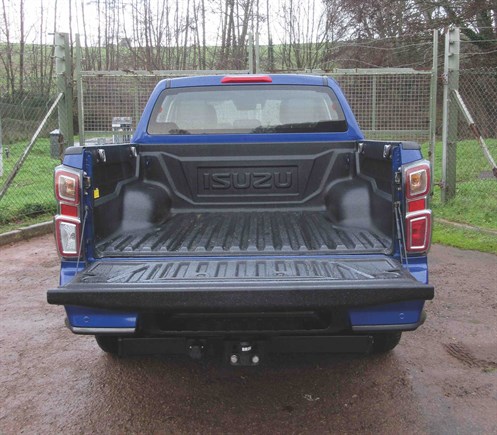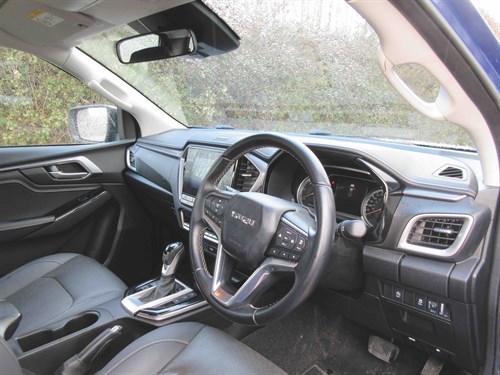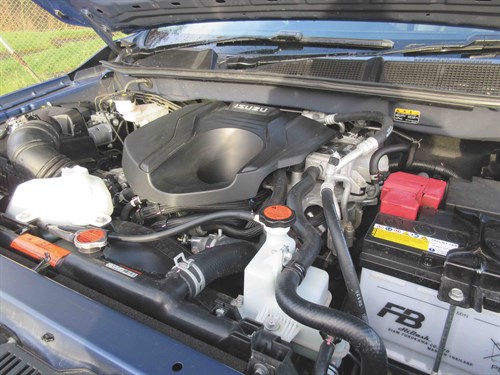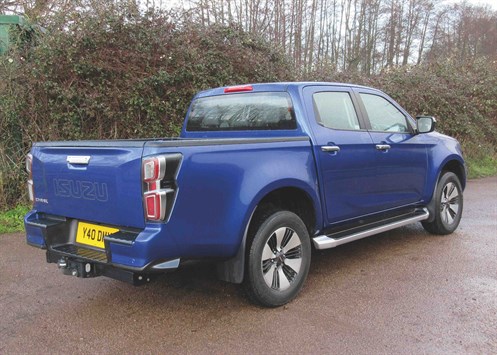Ensuring that all the sophisticated safety devices increasingly found on panel vans are fitted may not be the first requirement of anyone buying a 4×4 double-cab pick-up destined for off-road use. Far higher up the list of priorities are likely to be the truck’s capacity to ford streams and its ability to tackle steep, muddy, boulder-strewn slopes without getting stuck.
While such an attitude is understandable, even a 4×4 that spends much of its life squelching up farm tracks is likely to spend far more time trundling along ordinary roads in the company of other vehicles, cyclists, and wayward pedestrians.
As a consequence, the stress placed by Isuzu on on-highway accident-avoidance systems right across the current D-Max range makes solid sense. It has resulted in the pick-up being awarded a five-star Euro NCAP safety rating; the maximum that can be achieved.
It has also driven off with the What Van? Pick-up of the Year award for 2023. It won it the year before too.
With both 4×2 and 4×4 variants up for grabs, entry-level D-Max Business models with their Utility trim are sold with single-, extended- and four-door, five-seater double-cabs.
Moving up the range, DL20 and DL40 (the All-Purpose range) and V-Cross (the Adventure range) are marketed solely as 4x4s. All three are available as double-cabs with DL20 also listed with an extended-cab.
Mention should also be made of the extraordinary AT35 Arctic Trucks D-Max – ideal for touring the furthest-flung corners of Iceland, but a bit over the top for most UK builders and farmers.
A 1.9-litre diesel at 164hp is standard across the line-up with the choice of either a six-speed automatic or six-speed manual box depending on the variant you select.
Isuzu really now needs to follow the path trodden by Toyota’s indestructible Hilux and offer a more-powerful engine delivering at least 200hp as an alternative.
We tackled the pothole-strewn highways and byways of Herefordshire and a few of its fields in a D-Max DL40 double-cab automatic. Here’s how we fared.

Load bay
A substantial tailgate lowered with the assistance of a gas strut gives access to the load box, which in our case was protected by a plastic lining.
As is usual with modern 4×4 pick-ups, the tailgate rests horizontally when dropped down. The presence of a bulky rear bumper, which incorporates a step, means it cannot be lowered completely.
Both the front and back bumper are painted the same colour as the body.
Eight cargo tie-down points are provided, and our demonstrator came with a towbar. Maximum braked trailer towing capacity is a very-creditable 3.5 tonnes.

Interior and equipment
DL40 is not short of goodies with a roll call that includes heated front seats and climate control which can be altered to suit the individual requirements of the driver and front passenger.
The driver’s seat is electrically adjustable for height, reach and rake, as is its lumbar support.
A 7in multi-function touchscreen dominates the centre of the dashboard although many of the functions are controlled by two rows of buttons underneath. You use them to raise or lower the radio’s volume, switch the climate control on and off, change the temperature and alter the ventilation system’s fan speed among other tasks.
While they are slightly too small, their clarity of purpose is preferable to having to hunt around a touchscreen for ages when all you want to do is turn the fan down a notch.
A DAB radio with remote controls on the height and reach adjustable leather-trimmed steering wheel and Bluetooth connectivity are included in the deal along with Apple CarPlay and Android Auto.
A reversing camera and front and rear parking sensors make it easier to manoeuvre a somewhat bulky vehicle. A USB port sits next to the gearshift while a 12V power socket is mounted on the dashboard.
All four doors boast electric windows, and the exterior mirrors are heated and electrically-adjustable. Press a switch on the driver’s door, and they fold inwards.
In-cab storage facilities include a bin in each of the doors with a moulding for a bottle of water, a lockable glovebox and a lidded compartment on top of the fascia.
Also provided are a lidded bin between the front seats accompanied by a pair of cup-holders and a shelf just ahead of the gearshift lever. Look up, and you will find a compartment for your sunglasses just above the windscreen.
The glovebox in our demonstrator was occupied by one of the biggest, thickest owner manuals we’ve ever seen. Will anybody ever read it?
Turning to the rear seating accommodation, legroom for the two outermost passengers is acceptable, but restricted if you happen to be squatting on the central perch. All three seats come with lap-and-diagonal belts and adjustable headrests, and if the middle seat is unoccupied then the centre section of the back can be folded down and turned into an armrest with a couple of cup-holders.
A USB port and air vents are mounted in the rear of the console between the two front seats for the benefit of people sitting in the back, along with a hook on the rear of the front passenger seat so they have somewhere to hang their Friday night takeaway.
Turning to the safety standards referenced earlier, DL40 comes with Adaptive Cruise Control, Lane Departure Warning and Prevention, Intelligent Speed Limiter, Forward Collision Warning, Autonomous Emergency Braking. and Traffic Sign Recognition. The last-named feature tells you what the speed limit is on the road you are driving down and flashes a warning if it is being broken.
Present too are Emergency Lane-Keeping, Blind Spot Monitor and Rear Cross Traffic Alert. Misapplication Mitigation should ensure that disaster does not strike should you inadvertently slam your boot down on the accelerator rather than the brake pedal.
If all that were not enough, DL40 also features Brake Assist System, Traction Control, Hill Descent Control and Hill Start Assist. Trailer Sway Control will respond if a trailer you are hauling starts to snake and should hopefully bring things back under control by reducing your speed.
Multi-Collision Brake applies the brakes after any accident serious enough to trigger the airbags. This panoply of safeguards overlays the basic provision of ABS, Electronic Stability Control (ESC), and Electronic Brakeforce Distribution.
If things go awry despite the presence of all this protective technology, then you will be coddled by front, side, curtain, and centre airbags. A driver’s-knee airbag is installed as well.
Disc brakes are fitted at the front, while drums do the honours at the back.
Electronic power steering delivers a 12.5m turning circle kerb-to-kerb. D-Max’s suspension system makes use of McPherson struts at the front while leaf springs do duty at the rear.
Our truck’s 18in alloy wheels wore Dunlop Grandtrek AT25 265/60 R18 tyres. They help make the truck stand out, as do the silver sill bars which incorporate cab access steps.
The headlights dip automatically when oncoming vehicles are detected and revert to high beam when the vehicles have passed. A rain sensor triggers the windscreen wipers at the first sign of a downpour.

Powertrain
Fired up by a keyless push-button starter – you need the key fob to be present – the four-cylinder in-line diesel reaches maximum power output at 3,600rpm. Top torque of 360Nm kicks in across a 2,000rpm-to-2,500rpm plateau.
The D-Max employs AdBlue to ensure it complies with the Euro 6D exhaust emissions rules. The filler point for the 14-litre AdBlue reservoir sits next to the diesel refuelling
point underneath a flap on the truck’s nearside.
Driving
While 164hp may seem a lot of horses on paper, it is not all that generous if you are trying to propel a bulky 4×4 pick-up from A to B. This shortfall in power means that D-Max can be sluggish when accelerating off the starting line, with the automatic gearbox taking a little too long to shift from one gear to the next.
Matters improve once you are rolling though, with the kick-down facility proving remarkably brisk when you are trying to overtake slow-moving traffic. Maintaining the legal motorway speed once you have reached it is not too much of a problem, although the transmission’s reaction at even the sniff of an incline is to drop down a gear.
D-Max handles remarkably well for a large off-roader, and we swung briskly through bends with a growing degree of confidence – and while the on-road ride cannot be classed as outstanding, it is better than we expected it to be.
What is outstanding though is the unimpeachable build quality. This truck feels as though it will last forever.
More needs to be done about the noise emanating from beneath the bonnet. The engine can sound harsh at times, and extra attention needs to be paid to sound-deadening.
Returning to the subject of speed, while they cannot be classed as anorexic it is worth noting that all D-Max extended and double cab pick-ups weigh less than 2,040kg unladen.
This means they are subject to car rather than goods vehicle speed limits. The latter are 10mph lower on single and dual carriageways.
That allows you to maintain faster journey times without breaking the law – an advantage many of D-Max’s porkier competitors do not offer.
D-Max really comes into its own when you go off-road, and you can soon see why it appeals to farmers and builders.
Deeply rutted, muddy tracks leading to steep ascents and precipitous descents are all taken in their stride by a truck whose behaviour in the rough can only be applauded. Wading depth is 800mm.
The odd bump and bang emanating from its underside should not trigger a panic attack. A reinforced ladder chassis, a steel skid plate and a sump guard provide plenty of protection.
Four-wheel-drive could scarcely be simpler to engage, and you can engage it while D-Max is in motion. Just twist a knob at the bottom of the dashboard, which also enables you to select either a high- or a low-ratio set of gears depending on the challenges presented by your off-road trek.
Should you wish to you can switch from auto to manual mode by moving the gearshift lever to the right. Manual changes are easily executed.
Switches to engage the Hill Descent Control and rear diff lock are located to the right of the gear shift lever. A rear diff lock comes as standard.
The ESC and fuel-saving Stop and Start systems can be turned off, and if the going gets really rough then it’s a comfort to know that there are grab-handles on the A and B pillars. Handles are positioned above the door apertures too should you really need to cling on.
If the mud starts to fly however then cleaning it off the windscreen while in motion might be a problem. Mounted in the wiper arms, the windscreen washer jets aren’t terribly effective.

Operating
There is no arguing with the generosity of D-Max’s five-year/125,000-mile warranty. Roadside assistance in the UK and in European Union member states is included throughout its duration, and D-Max is additionally protected by a 12-year anti-corrosion warranty.
Service intervals are set at one year/12,000 miles. While that sounds somewhat short, it is an approach we condone given the strains and stresses going off-road can impose on components.
The onboard computer generates plenty of useful servicing information, including whether the oil needs changing and whether the air filter could stand swapping. The use of
LEDs for the headlights, daytime running lights, rear lights and front fog lights should help keep maintenance costs down given that they will seldom need replacing.
On the downside DL40 cannot be described as fuel-frugal, although 4×4 double-cab pick-ups with automatic boxes seldom are. We returned around 33mpg, which is at least better than the WLTP (Worldwide Harmonised Light Vehicle Test Procedure) 30.7mpg quoted by Isuzu.
A full-size spare wheel is a no-cost option with the tools and jack stowed behind the back seat, which folds down.
Our truck was finished in Sapphire Blue mica paint for an extra £500. Every paint finish bar plain white attracts the same premium.
Isuzu D-Max DL40 Double-Cab 4×4 automatic pick-up
Price (ex VAT) £32,604
Price range (ex VAT) £22,254–£47,104
Gross payload 1070kg
Load length 1495mm
Load width (min/max) 1080mm/1530mm
Load bay height 490mm
Loading height 838mm
Gross vehicle weight 3100kg
Braked trailer towing weight 3500kg
Residual value TBA
Cost per mile TBA
Engine size/power 1898cc, 164hp @ 3600rpm
Torque 360Nm @ 2000-2500rpm
Gearbox 6spd automatic
Fuel economy (combined WLTP) 30.7 mpg
Fuel tank 76L
CO2 241g/km
Warranty 5yrs/125,000mls
Service intervals 2yr/12,000mls
Insurance group 41
Price as tested £33,104
* after 48 months @ 20,000 miles a year – source – KWIKcarcost
Options
Blue mica paint £500
Rivals
Ford Ranger
Price range (ex VAT) £28,275–£48,000
Gross payload 652–1200kg
Braked towing weight 2500-3500kg
Engines 170hp, 205hp 2.0 diesel, 240hp 3.0 diesel, 292hp 3.0 petrol
Verdict: If you’re searching for an eye-popping pick-up and not too fussed about how much it can carry then take a look at the all-new Ranger Raptor. It’s on offer with a V6 petrol engine that bashes out almost 300hp and is guaranteed to leave all rivals standing. It’s the flagship of a recentlyrevitalised Ranger pick-up line-up that gives every sign of being just as successful as its predecessors.
SsangYong Musso
Price range (ex VAT) £24,515-£32,915
Gross payload 1050-1140kg
Braked towing weight 3200-3500kg
Engines 181hp 2.2 diesel
Verdict: While SsangYong doesn’t have the brand recognition of Isuzu, Ford or Toyota, that should not deter you from exploring what it has to offer. Covered by a decent warranty, its Musso 4×4 pick-up is a well-priced, well-built, competent off-roader specified to a decent level. Opt for the long-wheelbase Rhino variant if you need more carrying space. Dealer coverage has been boosted by the recruitment of former Mitsubishi sales outlets.
Toyota Hilux
Price range (ex VAT) £27,378-£57,627
Gross payload 1000-1030kg
Braked towing weight 3500kg
Engines 150hp 2.4 diesel, 204hp 2.8 diesel
Verdict: Hugely popular worldwide, the Hilux has a well-deserved reputation for being well-nigh unbreakable. Good to see that the latest model features a 200hp-plus diesel offering a long-awaited power boost. A star off-road, in its latest iteration Hilux comes with a restyled exterior, an upgraded interior and a variety of useful mechanical changes. Toyota is fast becoming a much more serious player in the UK LCV sector than it has been for years,
The Final Verdict
Design 10/10 – Isuzu deserves praise for installing so many possibly lifesaving safety devices.
Cabin 8/10 – Pleasant working environment, rear passengers may encounter space restrictions.
Ride 7/10 – Not outstanding, but better than you might expect. Copes pretty well.
Refinement 7/10 – Engine noise can be an issue, but build quality is top-notch.
Load area 8/10 – Does exactly what it says on the tin.
Handling/performance 7/10 – Former is surprisingly good for a 4×4 pick-up, but needs a more competitive engine.
Engine/transmission 8/10 – Automatic box felt sluggish but four-wheel-drive is easy to engage though.
Standard equipment 9/10 – Lots of kit is provided, with the heated front seats especially worthy of applause.
Operating costs 7/10 – A good warranty and LEDs keep costs down, but a 4×4 double-cab isn’t fuel-frugal.
What Van? subjective rating 8/10 – Incredible safety standards set by a solid workhorse that is no slouch off-road.
Overall Rating = 79/100





